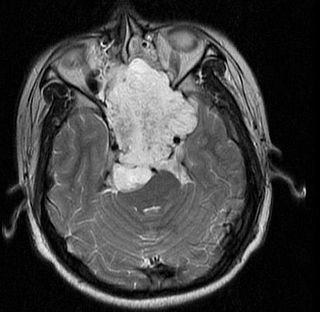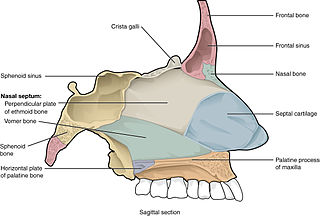
Radiation therapy or radiotherapy is a treatment using ionizing radiation, generally provided as part of cancer therapy to either kill or control the growth of malignant cells. It is normally delivered by a linear particle accelerator. Radiation therapy may be curative in a number of types of cancer if they are localized to one area of the body, and have not spread to other parts. It may also be used as part of adjuvant therapy, to prevent tumor recurrence after surgery to remove a primary malignant tumor. Radiation therapy is synergistic with chemotherapy, and has been used before, during, and after chemotherapy in susceptible cancers. The subspecialty of oncology concerned with radiotherapy is called radiation oncology. A physician who practices in this subspecialty is a radiation oncologist.

In medicine, proton therapy, or proton radiotherapy, is a type of particle therapy that uses a beam of protons to irradiate diseased tissue, most often to treat cancer. The chief advantage of proton therapy over other types of external beam radiotherapy is that the dose of protons is deposited over a narrow range of depth; hence in minimal entry, exit, or scattered radiation dose to healthy nearby tissues.

Anaplastic thyroid cancer (ATC), also known as anaplastic thyroid carcinoma, is an aggressive form of thyroid cancer characterized by uncontrolled growth of cells in the thyroid gland. This form of cancer generally carries a very poor prognosis due to its aggressive behavior and resistance to cancer treatments. The cells of anaplastic thyroid cancer are highly abnormal and usually no longer resemble the original thyroid cells and have poor differentiation.

Chordoma is a rare slow-growing neoplasm thought to arise from cellular remnants of the notochord. The evidence for this is the location of the tumors, the similar immunohistochemical staining patterns, and the demonstration that notochordal cells are preferentially left behind in the clivus and sacrococcygeal regions when the remainder of the notochord regresses during fetal life.

Fast neutron therapy utilizes high energy neutrons typically between 50 and 70 MeV to treat cancer. Most fast neutron therapy beams are produced by reactors, cyclotrons (d+Be) and linear accelerators. Neutron therapy is currently available in Germany, Russia, South Africa and the United States. In the United States, one treatment center is operational, in Seattle, Washington. The Seattle center uses a cyclotron which produces a proton beam impinging upon a beryllium target.

In radiotherapy, radiation treatment planning (RTP) is the process in which a team consisting of radiation oncologists, radiation therapist, medical physicists and medical dosimetrists plan the appropriate external beam radiotherapy or internal brachytherapy treatment technique for a patient with cancer.

Tomotherapy is a type of radiation therapy treatment machine. In tomotherapy a thin radiation beam is modulated as it rotates around the patient, while they are moved through the bore of the machine. The name comes from the use of a strip-shaped beam, so that only one “slice” of the target is exposed at any one time by the radiation. The external appearance of the system and movement of the radiation source and patient can be considered analogous to a CT scanner, which uses lower doses of radiation for imaging. Like a conventional machine used for X-ray external beam radiotherapy, a linear accelerator generates the radiation beam, but the external appearance of the machine, the patient positioning, and treatment delivery is different. Conventional linacs do not work on a slice-by-slice basis but typically have a large area beam which can also be resized and modulated.
Intraoperative electron radiation therapy is the application of electron radiation directly to the residual tumor or tumor bed during cancer surgery. Electron beams are useful for intraoperative radiation treatment because, depending on the electron energy, the dose falls off rapidly behind the target site, therefore sparing underlying healthy tissue.
"The Radiation Therapy Oncology Group (RTOG) was initially organized in 1968 under the direction of Simon Kramer as a national cooperative group for the purpose of conducting radiation therapy research and clinical investigations in order to treat cancers, including endometrial and cervical cancer. Funding from the National Cancer Institute (NCI) began in 1971.

Human papillomavirus-positive oropharyngeal cancer, is a cancer of the throat caused by the human papillomavirus type 16 virus (HPV16). In the past, cancer of the oropharynx (throat) was associated with the use of alcohol or tobacco or both, but the majority of cases are now associated with the HPV virus, acquired by having oral contact with the genitals of a person who has a genital HPV infection. Risk factors include having a large number of sexual partners, a history of oral-genital sex or anal–oral sex, having a female partner with a history of either an abnormal Pap smear or cervical dysplasia, having chronic periodontitis, and, among men, younger age at first intercourse and a history of genital warts. HPV-positive OPC is considered a separate disease from HPV-negative oropharyngeal cancer.

A brain metastasis is a cancer that has metastasized (spread) to the brain from another location in the body and is therefore considered a secondary brain tumor. The metastasis typically shares a cancer cell type with the original site of the cancer. Metastasis is the most common cause of brain cancer, as primary tumors that originate in the brain are less common. The most common sites of primary cancer which metastasize to the brain are lung, breast, colon, kidney, and skin cancer. Brain metastases can occur in patients months or even years after their original cancer is treated. Brain metastases have a poor prognosis for cure, but modern treatments are allowing patients to live months and sometimes years after the diagnosis.
Simon N. Powell is a British cancer researcher and radiation oncologist residing in New York City.
The term radiogenomics is used in two contexts: either to refer to the study of genetic variation associated with response to radiation or to refer to the correlation between cancer imaging features and gene expression.
Wolfgang Axel Tomé is a physicist working in medicine as a researcher, inventor, and educator. He is noted for his contributions to the use of photogrammetry in high precision radiation therapy; his work on risk adaptive radiation therapy which is based on the risk level for recurrence in tumor sub-volumes using biological objective functions; and the development of hippocampal avoidant cranial radiation therapy techniques to alleviate hippocampal-dependent neurocognitive impairment following cranial irradiation.
Docrates Cancer Center is the first and currently the only private hospital in the Nordic countries that comprehensively specialises in cancer treatment. It operates in Helsinki, Finland. It characterises its operations as those complementing the public sector. Docrates Oy was established in 2006 and the hospital started its operations at the premises of Eira Hospital in autumn 2007. It moved to its own premises in Jätkäsaari, Helsinki, in 2009, where it has hospital rights. There is a ward and Health and Recovery Center located at Docrates Cancer Center. Among other things, diagnostics, pharmacotherapy, radiation therapy and isotopic treatments are carried out at the hospital. Cancer surgeries are performed in partner hospitals. Docrates also participates in clinical trials and the testing and development of new treatments.
Temporal lobe necrosis is a late-stage and serious complication usually occurring in persons who have undergone radiation treatment for nasopharyngeal carcinoma (NPC). It is rather rare and occurs in 4-30% of patients who receive radiation treatment for NPC. Many patients who experience temporal lobe necrosis are asymptomatic. This demonstrates a need for consistent imaging follow up, such as MRI and/or PET/CT, to help with the potential management of it. Those who are symptomatic usually suffer from "vague" symptoms including headaches, dizziness, intracranial pressure, personality changes, seizures, and short-term memory loss. The rarity of this disease has led to difficulty in finding optimal treatments, however, most treatments include one or some of the following: steroids, hyperbaric oxygen, surgery, and decadron.
Christopher M. Nutting is a British Professor of Clinical Oncology and medical consultant, specializing in head and neck cancers, who has helped develop Intensity-Modulated Radiotherapy (IMRT), an advanced form of Radiation therapy.
Sandro Porceddu is a head and neck radiation oncologist at Brisbane's Princess Alexandra Hospital and a Professor with the University of Queensland. He was president of the Clinical Oncologic Society of Australia (COSA) and chair of the Trials Scientific Committee of the Trans Tasman Radiation Oncology Group (TROG).

Paranasal sinus and nasal cavity cancer is a type of cancer that is caused by the appearance and spread of malignant cells into the paranasal sinus and nasal cavity. The cancer most commonly occurs in people between 50 and 70 years old, and occurs twice as often in males as in females. During early phases of the cancer, symptoms may include nasal obstruction and hyposmia, as well as other symptoms. More symptoms may develop as malignant cells further grow and spread into other nearby tissue such as the palate or orbital floor. X-rays of the head and MRI can aid in diagnosis of the cancer while tumor resection surgery, radiation therapy and chemotherapy can be used for treatment of the cancer.
Diffusing Alpha-emitters Radiation Therapy or DaRT is an alpha-particle-based radiation therapy for the treatment of solid tumors.










